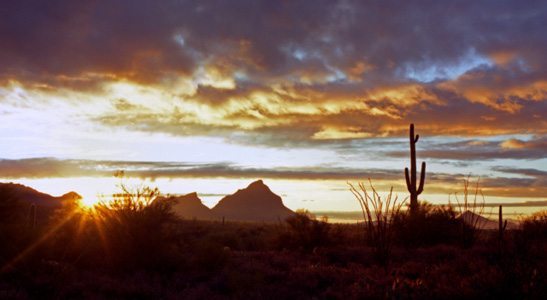
Arizona State Land Commissioner Vanessa Hickman manages the leasing, sale and highest use of roughly 9.2 million acres of Arizona State Trust land, a huge portion of which is meant for K-12 education. As the president of the Western States Land Commissioners Association, to which Phoenix is the winter conference host Jan. 4 through 8 at the Arizona Biltmore Resort and Spa, Hickman answered questions about important land issues.
Sales in past two years: $100
Sales proposals in the pipeline: $1B
Commercial ground leases being negotiated in urban areas: $1B over term
ASLD has negotiated and approved: 3 solar leases and 3 wind farms on state trust land
HOW DO PROPOSED CHANGES TO THE CLEAN WATER AND ENDANGERED SPECIES ACTS AFFECT ARIZONA DEVELOPMENT AND LONGTERM LAND VALUE?
The effects of these acts, as they continue and are expanded, could have major impacts on State Trust Lands and other lands across the state. They have the potential to severely restrict development opportunities, require additional off-sets and set-asides and subsequently lower land values for most types of urban and rural lands. The ultimate impacts could severely hinder economic development and land values in Arizona for years to come.
A TRUSTED LEGACY – When Arizona became a state in 1912, it was endowed with 10 million acres of land to be held in trust and to benefit public institutions, most of which is dedicated to K-12 education. Today, there are about 9.26 million acres still held in trust. Here is where they fall.
WHAT SOLUTION DO YOU SUGGEST TO AVOID OR PREPARE FOR THESE POTENTIAL ISSUES?
The most important thing land management agencies, private development entities and all interested parties can do is engage. We need to study and understand the proposals, such as the new CWA rule regarding Army Corps 404 jurisdiction, and make comments to the appropriate federal agencies regarding out findings and opinions. We need to understand the type, number and extent of new species being proposed to the U.S. Fish and Wildlife Service for listing as endangered species and be prepared to make our comments and opinions known. We need to question all new actions, be proactive to every degree possible and be prepared to deal with possible listings of proposed threatened or endangered species through responding with sound science, exploring available options, including candidate conservation agreements with assurances, habitat conservation plans and any other means to limit the ultimate impacts of exiting of proposed endangered species. We need to collaborate — public and private sector — as interested and impacted parties and work together and with the federal agencies to make our positions known and work toward equitable solutions.
ONE THING I FOUND VERY INTERESTING ABOUT THE WAY STATE TRUST LAND IS USED IS FOR CONSERVATION. CAN YOU EXPLAIN HOW DEVELOPERS “LEASE” LAND THEY AREN’T ACTUALLY GOING TO DEVELOP ON AND WHAT THEIR MOTIVES WOULD BE?
The land department has historically sold and leased land for conservation purposes. One example would be the long-term ground lease of state land for mitigation due to development impacting habitat of a threatened or endangered species. The state could also enter into agreements for mitigation banks, a partnership where a state land lessee could pay for and provide for conservation of state lands, receive credits for impacted 404 washes in order to develop other state or private lands, or sell credits to other parties generation additional compensation for the trust. The motivation of a developer would be to generate revenue for the sale of credits or to have a reliable and secure source of mitigation or conservation lands, which they would need to secure in order to allow their project to go forward, pursuant to requirements of federal law.
MINING FOR MILLIONS
Mining is an important component of the Arizona State Land Department’s (ASLD) land
and resource management portfolio. The ASLD manages mining and mineral activity by
authorizing mineral exploration, production, aggregate development, oil and gas leases, and
Special Land Use Permits for a variety of other revenue-producing, mining-related activities.
Income to the Trust from mining and mineral activity is generated primarily from royalties
paid on mineral production. Total income to the Trust during fiscal year 2014 was more than
$16 million. Well over half of that revenue was generated by copper production.
Interest in mining exploration has remained constant throughout the years and is
spread throughout the Trust land portfolio. Over the past three fiscal years, the ASLD has
processed thousands of mineral-related applications with two-thirds of those for mineral
exploration. Mining activity on State Trust lands are important economic drivers to local
communities by generating jobs and supporting local and regional businesses. Mining
production contributes important resources and economic benefits to our state and national
manufacturing needs. — Richard Thompson, Director, Natural Resource Division, ASLDCOMMISSIONED EXCHANGE
Occasionally, land owners and managers are faced with situations that have a negative
effect on the value and use of their property. For example, one landowner may find
the economic value of his parcel of land is diminished because it is trapped within the
boundaries of another land owner where it lacks physical, feasible or legal access of any
kind. When that trapped land is located within the boundaries of federally owned land, such
as a military reservation or national monument, the solution can become very complex. A
tool of land owners and managers that is thought to have value in solving such ownership
problems is the “land exchange.”
The Arizona State Land Commissioner may now conduct land exchanges following a
2012 amendment to the State Constitution, as referred by the legislature and approved by
the voters. Proposed land exchanges will take time to complete and will be subject to many
procedural requirements. Final approval is conditioned upon a favorable, statewide vote. The
Arizona State Land Department is now implementing this program.
— Richard Thompson, Director, Natural Resource Division, ASLD
THE ARIZONA STATE LAND DEPARTMENT’S (ASLD) URBAN LANDS LEASE AND SALE PROGRAM IS THE LARGEST REVENUE PRODUCER FOR THE TRUST. HOW MUCH REVENUE HAS THAT BROUGHT TO THE TRUST?
Monies generated from the permanent trust fund, and expendable revenues generated from things such as leases and permits are distributed directly to the trust beneficiaries. The permanent trust fun now totals $4.5B, which is twice what it was only five years ago. Sales and commercial leases account for the majority of revenue generated by the ASLD and average about 80 percent of our revenues





